Collapse by Brandon Ballengée
Collapse is a visualization of an ecosystem that has threatened the Gulf of Mexico from the Deepwater Horizon oil spill. The installation is a pyramid of specimen models and it contains thousands of different specimens representing the ecosystem that has been threatened by the oil spill.
Collapse is a visualization of an ecosystem that has threatened the Gulf of Mexico from the Deepwater Horizon oil spill. The installation is a pyramid of specimen models and it contains thousands of different specimens representing the ecosystem that has been threatened by the oil spill.
“Collapse responds to the global crisis of the world’s fisheries and the current threat for the unraveling of the Gulf of Mexico’s food chain following the 2010 BP Deep Water Horizon oil spill. The large-scale installation created a pyramid display of 26,162 preserved specimens, which represented 370 species of fish and other aquatic organisms in gallon jars. It is meant to recall the fragile inter-relationships between Gulf species. Empty containers represented species in decline or those already lost to extinction.”
Visualizing an Ecosystem
I find Collapse to be a very interesting way of inviting a viewer to visualize an ecosystem and the interconnectivity of these specimens through the use of a contemporary art installation. It is beneficial to see the work of science from a different perspective – one that allows the public to engage while at the same time possibly providing the scientists with a different perspective on their own work. With twenty-first century advancements in media, communication and the internet, we are aware, now more than ever, that knowledge production does not belong to one single discipline. This accessibility is carried over into the gallery and exhibition space, bending the boundaries between scientists and artists and allowing for perspectives from different epistemologies.
Informed Understanding
Ballengée is trained as an artist, a scientist, and an environmental educator. He wears several hats and blurs their boundaries in his work. From the standpoint of the science community, his works are not voyeuristic; they are informed because he is bringing in the authority of science education as well as art, and he moves very elegantly between the two.
Ballengée teaches at the Nature and Technology Lab at the School of Visual Arts, New York. His background in environmental science led to their acquisition of a chemical hood where the preservation of specimens and cleaning and staining of aquatic animals could take place. The lab is the first fully functioning, first level biology lab at an art school in the United States. This lab, along with other art-based research laboratories like SymbioticA, signals a growing trend in the way artists are being trained. Artists who choose to work with scientific themes gain insight into the issues and processes, lending authority to their work.
In Collapse, Ballengée is bringing to the table an informed understanding of an ecosystem. The use and display of specimens preserved in jars evokes a tradition of scientific display. By doing this, Ballengée references scientific methodology (and the history thereof) in the way the specimens are collected, preserved and archived. He invites the viewer to compare scientific display in an art context. It is a way of engaging the public and challenging them to think about things differently. One can write about the ecosystem being affected by the Deepwater Horizon oil spill in a textbook, but is it going to have the visual impact of this magnificent pyramid of specimen bottles glowing in the center of a gallery when you walk in?
No comments yet. Why not add the first?
Acknowledgements & Credits
In collaboration with Todd Gardner, Jack Rudloe, Brian Schiering and Peter Warny.
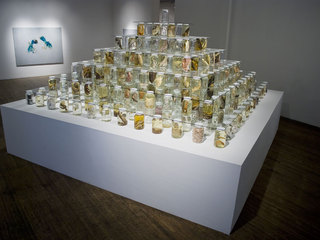
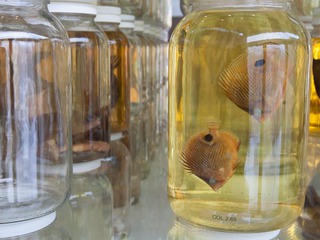
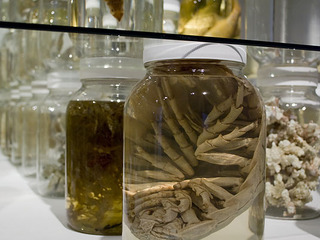
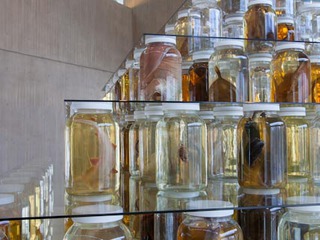
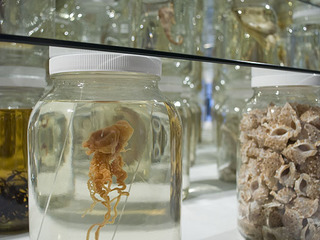
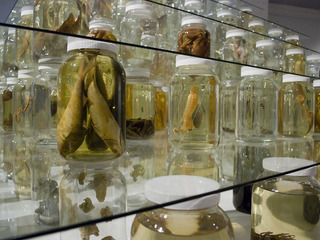
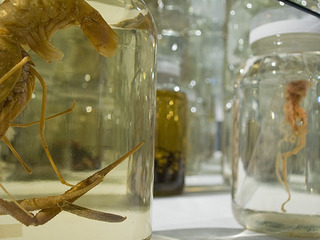
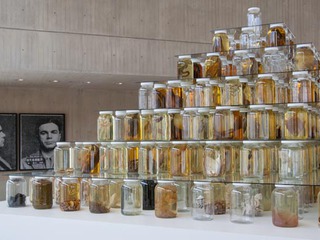
← Back to work
0 Comments